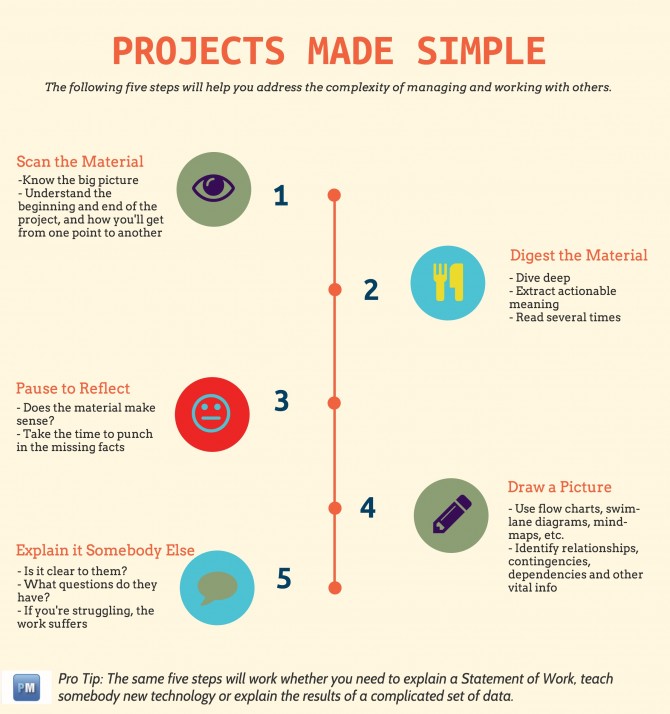Everyone has heard of the KISS method — Keep It Simple, Stupid.
Nowhere is that more important than in project management. Yet you’ve undoubtedly come across people in your project management career who enjoy taking the simplest of concepts or project tasks and making them needlessly complicated, confusing and confounding.
It’s an art to simplify. The truth is that it takes skill to take what is complicated and boil it down into its simplest form. Skilled simplifiers take what is popularly called the beginner’s mind, a Zen approach to break things down to the basics and experience the world as if you’re newly born to it.
You’ll have many opportunities as a project manager to introduce new concepts and ideas to your team and clients. There are always new technologies, processes, interactions among various groups, and scores of moving parts at any given moment in time. Rather than spend your time making tasks and ideas even more complicated, focus on making them as simple as possible by taking the following five steps.

First, the scenario: A client approved a 12-page Statement of Work (SOW) and it has been handed to you. You must explain the scope of work to your team so everyone can get an understanding of what the final deliverable looks like and start working on their pieces.

- Scan the Material – The first step is to just scan over the document itself. You don’t need to spend a lot of time in any particular area, but rather just get an overview of the project from beginning to end. At this point you need to see the big picture, or the forest for the trees. You need to understand what the beginning looks like, what the end looks like, and have a rough idea of the path that will get you and your team from start to finish.
- Digest the Material – Once the general outline takes shape in your mind, go back and do the deep dive. This is when you dig into every word and sentence to extract actionable meaning from the SOW. You will want to have a highlighter and pen with you during this exercise, and get away from distractions such as email, phones, or anything else that will cause your mind to start, stop, start, and stop over and over again. Highlight important objectives and milestones, make notes where more clarification is needed, and write down questions and thoughts in a notebook for later reference and simplicity. You may need to go through the document a number of times in order to make sure you understand it completely, which leads to step three.
- Pause to Reflect – Take a few moments and ask yourself, “Does this make 100% sense to me?” You need to be intellectually honest here. There may be parts of the document that truly don’t make any sense to you, but you either fool yourself into thinking you understand, or convince yourself that it will make more sense later. Don’t delude yourself. Take the time to uncover or discover whatever facts are missing. If you find that you don’t understand certain areas, go find the right person to talk to that will help fill in the gaps or answer any questions you may have. You’ll need the answers later when you’re explaining it to someone else. Rest assured that if you have questions, others will too, so take the time to get them answered.
- Draw a Picture – A picture is worth a thousand words, and the same is true when it comes to understanding a complex subject. We’re not talking about creating a Picasso or DaVinci here, but we are talking about using flow charts, swim-lane diagrams, mind-maps or whatever type of diagram you prefer to get the point across. Putting a complex subject or process into a diagram helps identify relationships, contingencies, dependencies, and other vital information that you will need to describe to someone else. It will also make apparent any gaps or missing information.
- Explain it Somebody Else – Once you’ve gone through the four steps above, you are now ready to explain a complicated and involved subject to somebody else…simply. Do a dry run with one or two colleagues and see if what you’ve put together makes sense to them. What questions do they still have? Is there a look of confusion on their face? If so, you haven’t made things simple enough and need to do more work to get there. Once you’ve answered all their questions and wiped that confused look from their face, you’re ready for prime time.
The same five steps will work whether you need to explain a SOW, teach somebody new technology, or explain the results of a complicated set of data. Remember, complexity is not a virtue. You want people to understand what you are saying, but first YOU must understand. You’ll be delighted with the results when the light bulbs that turn on over everyone’s heads illuminate the room!
With ProjectManager.com you can create detailed project reports in just three clicks, report on all the tasks in your project, include the actual versus planned progress, and identify whether the project is currently on track.

